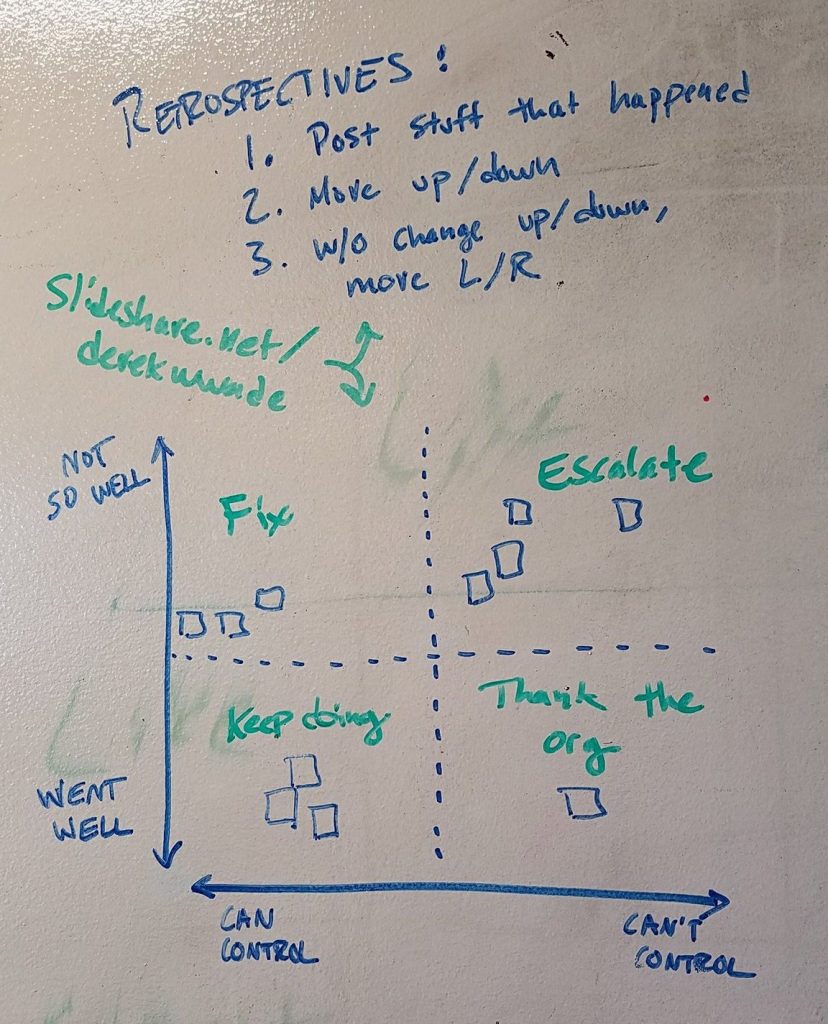Having distributed team members is always a challenge in many aspects
How can you liberate a meeting without using Liberating Structures?
There is enough LS which you can use to make your meeting productive. However, if you have the feeling that they are overused or you are bored with them, think about the five elements and create your structure.
- Structuring Invitation
- How Space Is Arranged and Materials Needed
- How Participation Is Distributed
- How Groups Are Configured
- The sequence of Steps and Time Allocation
An example of a retrospective with a new team:
Situation: we have a team of 10 colleagues. A developer and I had just started on the team.
STEP 1:
Ask the group to create two teams and give them the following assignment per team:
Team 1: take 10 minutes to think of all the reasons why this team is the worst team ever. after the 10 minutes, try to convince me that I have made a bad choice to join the team.
Team 2: take 10 minutes to think of all the reasons why this team is the most impressive team ever. After 10 minutes, try to convince me that I have made an excellent choice to join this team.
STEP 2:
After both presentations, give the next assignment:
Team 1: take 15 minutes to discuss within your team what actions can be made to keep the most positive things that team 2 had mentioned.
Team 2: Take 15 minutes to think of actions we can take to dismiss some of the reasons that team 1 had mentioned.
STEP 3:
After both presentations, ask each one in the group to think about the actions mentioned in Step 3 and take five minutes individually to find out how they can contribute to making those actions a success. You can also participate in this. We then share our contributions. Asked them to memorize their contributions, and get back to them in a few sprints.
The original post
Create shared understanding with ‘What, So What, Now What’
In this post, The Liberators explain the Liberating Structure What, So What Now What and how they use this structure within the context of Scrum.
Read the complete article here: https://medium.com/the-liberators/create-shared-understanding-with-what-so-what-now-what-6dda51d5bcf9
Retroformat for teams that have not yet experienced a useful learning retrospective

Things they can’t control and hold them back… Escalate. Inform mgmt, coaches, etc.
How to facilitate this: https://www.slideshare.net/derekwwade/team-coursesprint-retrospective-module
Found this information on Twitter: https://twitter.com/DerekWWade/status/992842247895945216
A Retrospective with Liberating Structures at a rapidly growing startup
Read about a retrospective The Liberators facilitated for a rapidly growing startup using a string of Liberating Structures: https://medium.com/the-liberators/a-retrospective-with-liberating-structures-at-a-rapidly-growing-startup-e90a255ce848
Retrotip: Treasure Map

Invite your team to form groups and have them create a treasure map based on their journey so far (or the past couple of Sprints). What is the treasure they’re looking for? What obstacles and traps are on their way? What hidden temples have they found? After twenty minutes of creative work, let the groups present their treasure maps and work together to identify themes and find improvements.
I stole this retrorip from The Liberators 😉
How to do a Retrospective using Flow Metrics
In this article you can read how Christian Hofstetter has applied flow metrics to run a retrospective with the goal to gain more insight and deciding what to do to improve.
You can find the article here: https://medium.com/the-liberators/how-to-do-a-retrospective-using-flow-metrics-612bf48bdeba
Introduction videos by Carsten Lützen
Carsten Lützen created a lot of introduction videos that can be found here: https://www.youtube.com/channel/UCDvr4dS873jCpYDCEtBBW8g/videos
Some exampels of these video’s are:
The Retrospective: A known recipe for improvement — with my own spice
- Set the Stage
- Look Back
- Gather Data
- Generate Insight
- Decide What to Do
- Close the Retrospective
Read the complete post here: https://medium.com/path-pattern/the-retrospective-a-known-recipe-for-improvement-with-my-own-spice-da534c6628cc
The Agile Board: 100 resources for agile teams
Irene Francés likes to share a board that she has been working on during the last couple of weeks. It is meant to capture the main agile resources she came across and found useful. https://loom.ly/7-gQgjs
